Many clients — especially from the Caucasus and Central Asia — often ask me the same question: Which country is best to buy used printing equipment from? And each of them wants to buy a printing machine from… From Germany. of course!
It’s a logical concern. After all, printing machines are a major investment, and everyone wants to get the most value for their money. But the truth is, there’s no definitive answer. I’ve seen excellent machines that came from Africa, and completely worn-out ones from Germany. There’s no magic formula. The country of origin is just one factor, and not the most important one.
That said, it’s fair to say that the most reliable equipment typically comes from developed countries, where printing companies benefit from regular technical support and official servicing. When a country has authorized dealers for brands like Heidelberg, Komori, or Manroland, along with local spare parts warehouses and trained service engineers, machines tend to be maintained better and last longer. Access to fast delivery of parts is especially critical — even the best machine will eventually need replacements, and downtime can be very costly.
German origin does not mean good treatment
Clients often assume that “German equipment” automatically means quality. After all, most printing presses are manufactured in Germany. But this assumption is misleading. Yes, the machine may have been made in Germany — but what really matters is how it was used. In one print shop, the same model might be meticulously maintained, cleaned regularly, and operated within optimal parameters. In another, it might be neglected and pushed beyond its limits — leading to premature wear and performance issues.
One of the most underestimated factors is the human one. The way a machine was treated by the operator matters more than its location. A skilled and caring operator who follows proper maintenance routines can preserve even a 20-year-old press in excellent condition. On the other hand, careless handling can ruin a new machine in just a couple of years.
Moving is always stressful
Another key aspect is how the machine is taken out of production. Who dismantles it? How is it stored and shipped? Sometimes the transportation process causes more damage than years of operation. So it’s essential not only to know the country of origin but also to assess who is responsible for removal, how it’s packaged, and who will handle installation and commissioning.
In short, the country can be a helpful indicator — but it’s not a decision-making criterion. If you’re working with a professional inspection service that tests the machine, verifies its wear and tear, and provides an honest technical report, the geography becomes less relevant. There are machines that have worked for decades in Eastern Europe or Guatemala and still produce outstanding results. And then there are others from Central European countries that are unrepairable after just a few years.
Openness of the economy
One of the alarming factors is always the presence of customs duties on spare parts in the country. The main question is how quickly the local dealer can deliver the spare part to the place of breakdown. If the spare part is delivered within a day, but customs clearance takes three to four days, the machine owner will make every effort to repair it using makeshift methods. As a result of such manipulations, the printing machine eventually turns into a monster with lots of homemade parts and repairs made with electrical tape and a soldering iron.
The takeaway is simple: focus on the specific machine, its condition, and its history — not just the country it comes from. And if you want to minimize risk, bring in an expert who can detect hidden flaws and give you a clear assessment. That’s exactly what we do.



